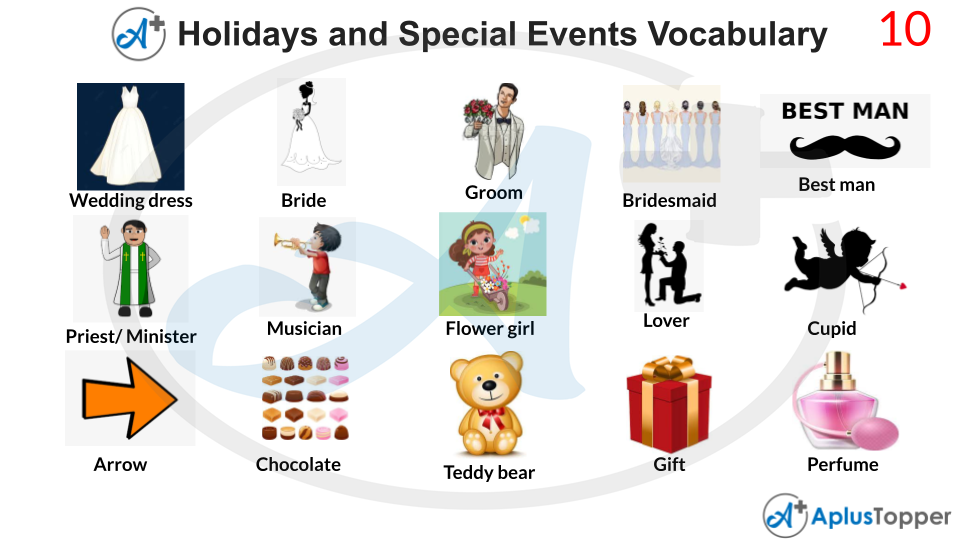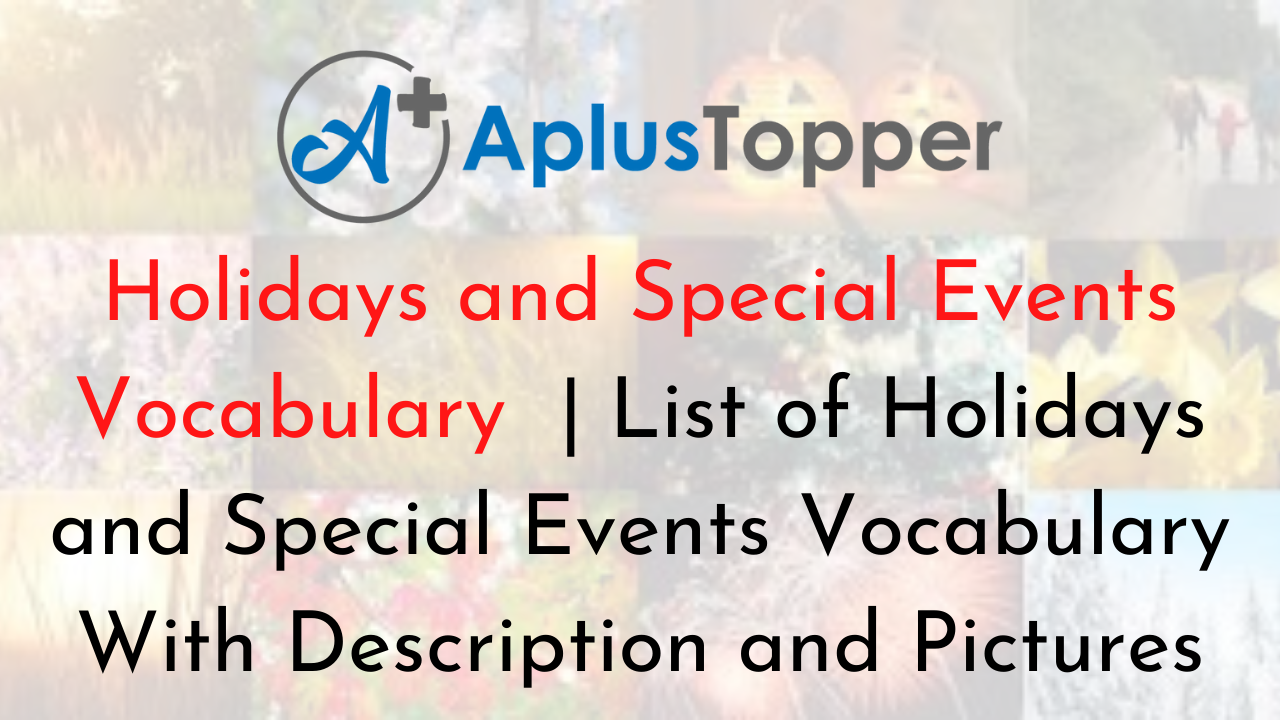Holidays and Special Events Vocabulary: There are a lot of words associated with holidays in general. Still, vocabulary about different holidays comprises significant words which prove useful and valuable when you are a complete beginner in English and don’t know how to get started.
To help one get started, we’ve put up a hand-picked list of holiday vocabulary just for you which includes summer holiday vocabulary and also various holiday words and phrases.
List of Holiday Vocabulary Words in English
Name of Holiday Vocabulary Words
When it comes time to celebrate, you’ll need to be able to discuss the names of holidays in the English language, so brush up on your knowledge of the language. On a variety of occasions throughout the year, English-speaking countries observe a public holiday in their respective countries.
Some of these holidays are celebrated all over the world, while others are honoured only in these specific nations. In this part, you will be able to expand your vocabulary even further by learning the English names for a range of holidays and festivals. This documents contents more than 50 awesome holiday words..
List of Holiday Vocabulary
- Christmas Vocabulary
- Easter Vocabulary
- Halloween Vocabulary
- New Year’s Eve Vocabulary
- Summer Vocabulary
- Wedding and Marriage Vocabulary
- Valentine’s Day
Description of the Holiday Vocabulary Words
A birthday is the literal or symbolic anniversary of a person’s or institution’s birth. People’s birthdays are commemorated in a variety of cultures with birthday presents, cards, a celebration, or a rite of passage.
Example: Tara’s birthday falls on a Sunday this year, which is unusual for her.
April Fools’ Day, often known as April Fools’ Day, is an annual tradition on April 1st that involves practical pranks and hoaxes. Jokers frequently reveal their deception by yelling “April Fools!” at the target. These pranks might include the mass media, which could be exposed the next day.
Example: April Fools’ Day is also one of the shortest holidays of the year, lasting only a few hours.
Christmas is an annual holiday honouring the birth of Jesus Christ, celebrated by billions of people throughout the world predominantly on December 25 as a religious and cultural event.
Example: Are you returning home for the holidays?
Father’s Day is a celebration that celebrates paternity, paternal ties, and the impact of dads on society. Since the Middle Ages, the 19th of March has been observed as Saint Joseph’s Day in Catholic nations throughout Europe.
Example: On Father’s Day, I’ll make a phone call to my father.
Easter, also known as Pascha, Zatik, or Resurrection Sunday, is a Christian celebration and cultural event honouring Jesus’ resurrection from the dead, which the New Testament describes as taking place on the third day after the execution by the Romans at Calvary in c. 30 AD.
Example: They always attend church throughout the Easter season.
Halloween, also known as Allhalloween, All Hallows’ Eve, or All Saints’ Eve, is a worldwide festival held on the eve feast of All Hallows’ Day on October 31 of the Western Christian.
Example: I once wore a dress to a Halloween party, and it was really comfortable.
International Women’s Day (IWD) is a global celebration commemorating women’s cultural, political, and economic achievements. It is observed yearly on March 8th. It’s also a key point in the women’s rights movement, raising awareness about problems like gender equality, reproductive rights, and abuse and violence against women.
Example: The day before International Women’s Day, her husband surprised her with a bouquet of lovely flowers.
Mother’s Day is a holiday honouring a family’s or individual’s mother, as well as motherhood, maternal connections, and mothers’ impact in society. It is observed on various days across the world, most notably in the months of March and May.
Example: We sent flowers to Mom in honour of Mother’s Day.
Labor Day is known as a federal holiday in the United States that is observed on the first Monday in September to acknowledge and honour the American labour movement, as well as the labourers’ efforts and contributions to the country’s progress and successes. It’s the Monday after Labor Day Weekend, which is a four-day weekend.
Example: I wish you a very enjoyable and peaceful Labor Day weekend.
The last day of the year is considered New Year’s Eve (also known as Old Year’s Day or Saint Sylvester’s Day in various countries), falls on December 31 in the Gregorian calendar. New Year’s Eve is presently celebrated in many countries with nighttime celebrations when people dance, eat, drink, and watch or light fireworks.
Example: On New Year’s Eve, we’ll be throwing a party.
Thanksgiving is observed in Canada on the second Monday in October, in the United States on the fourth Thursday in November, and in other countries around the same time. It all started with a day of thanksgiving and sacrifice for the blessings of the harvest and the previous year.
Example: I really wish you could have joined us for Thanksgiving dinner.
Summer vacation, often known as summer break, is a school break that occurs in the summer between school years and the academic year’s break. Students, but not staff, are usually off for eight to nine weeks, depending on the nation and district.
Example: During his summer break, he went to Russia for the first time.
Valentine’s Day, also called the Feast of Saint Valentine or Saint Valentine’s Day, falls on February 14 every year. It began as a Christian feast day honouring one or two early Christian martyrs named Saint Valentine and has since evolved into an important religious, cultural, and commercial celebration of romance and love in many parts of the globe, thanks to subsequent folk traditions.
Example: On Valentine’s Day, she was surprised by a bunch of red flowers.
Children’s Day is a memorial day held every year in honour of children, with the date varying per nation. In Geneva, during the World Conference on Child Welfare in 1925, the first International Children’s Day was declared.
Example: On International Children’s Day, children under the age of 12 are eligible to free admission to all city parks.
A wedding is a religious event in which two individuals get married. Cultures, ethnic groups, religions, nations, and socioeconomic strata all have different wedding traditions and customs. The majority of wedding ceremonies include a couple exchanging marital vows, a gift (offering, rings, symbolic object, flowers, money, or dress) being presented, and a public pronouncement of marriage by an authorized person or celebrant.
Example: As of the current circumstances, we haven’t settled on a date for the wedding.
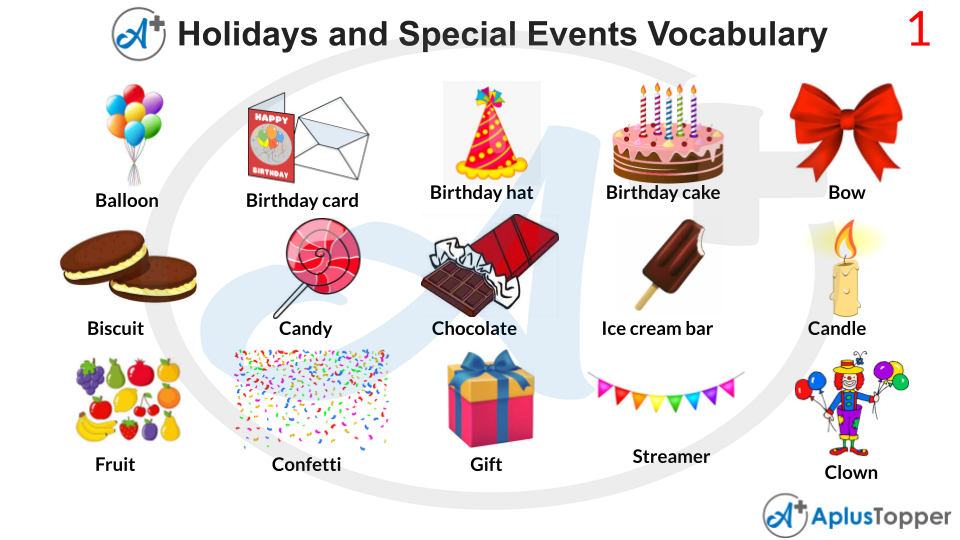
Birthday Vocabulary
A balloon is a flexible bag that may be filled with helium, hydrogen, nitrous oxide, oxygen, or air and then inflated. Modern balloons are constructed of a variety of materials, including rubber, latex, polychloroprene, and nylon fabric, and come in a variety of colours.
A birthday card is a greeting card that is presented or sent to someone on their special day. Birthday card customs vary by country, much like birthday cake traditions, although the origins of birthday cards are unknown. With the development of computing and the introduction of the internet and social media, electronic birthday cards and even Facebook postings have become popular ways to send birthday greetings.
A party hat is any of several types of celebratory hats, the most common of which is a conical hat made of thin paperboard with designs printed on the outside and a long string of elastic acting as a chinstrap, running from one side of the cone’s bottom to the other to secure the cone to the person’s head. Party hats are most commonly worn at birthday parties, particularly by the honoured guest, or at New Year’s Eve celebrations.
A birthday cake is a cake that is served at a birthday party. Layer cakes with icing are frequently presented with little lighted candles on top to signify the celebrant’s age. Cupcakes, cake pops, pastries, and tarts are examples of variations.
A biscuit is a baked food product made from flour. Biscuits are usually hard, flat, and unleavened in most nations, notably in the Commonwealth and Ireland. Sugar, chocolate, frosting, jam, ginger, or cinnamon are commonly used to make them sweet. They can also be savoury and have a cracker-like texture.
Candy, commonly known as sweets or lollipops, is a delicious confection made primarily of sugar. Any sweet confection, such as chocolate, chewing gum, and sugar candy, fall under the genre of sugar confectionery.
Chocolate is a liquid, solid, or paste produced from roasted and powdered cacao pods that may be utilised as a flavouring ingredient in other dishes or consumed on its own.
Chocolate is known as one of the most popular food kinds and flavours in the world, and many sweets, including cakes, pudding, mousse, chocolate brownies, and chocolate chip cookies, include chocolate.
A frozen treat on a candy bar or a stick with ice cream is known as an ice cream bar. The coating is generally a thin layer of chocolate that prevents the ice cream from melting and spilling. The ice cream bar is not to be confused with the popsicle, which contains no ice cream.
A candle is a combustible solid material, such as a tallow, with an ignitable wick that produces light and, in some circumstances, scent. A candle can also be used to generate heat or as a timekeeper. Traditionally, a chandler is someone who manufactures candles.
In botany, a fruit is a structure of seed-bearing that develops from the ovary after blooming in flowering plants. Fruits are the vehicles that blooming plants use to disperse their seeds. Edible fruits, for example, have long been propagated by people and animals in a symbiotic connection that serves as a means of seed dispersion for one group and sustenance
Confetti is a term for little bits of paper, mylar, or metallic material that are thrown during events such as parades and weddings. The word confected comes from the Latin word confected, while confetti is the plural form of the Italian word confetti, which means tiny sweet.
A gift, often known as a present, is anything given to someone without expecting anything in return. If the person receiving the present already owns the item, it is not considered a gift. Although there may be an expectation of reciprocity when making a gift, it is intended to remain unrequited.
A clown is a character with distinctive make-up and flashy clothing which uses physical humour to execute comedy in an open-minded manner (by inverting folkways).
Present tags give the gift a unique look and complement the box. Many gift tags come with strings that may be used to tie them to the items. Present tags give the gift a unique look and complement the box. Many gift tags come with strings that may be used to tie them to the items.
A party horn, also known as a party blower, party pipe, party elephant, party blowout, party noisemaker, party whistle, ta-doo-dah, noise popper, birthday kazoo, or blow tickler, is a horn made from a paper tube that unrolls when blown into, making a horn-like noise.
Popcorn is a type of maise kernel that expands and puffs up when heated; the same name is also applied to the meal that results from the expansion. The sturdy hull of a popcorn kernel holds the seed’s hard, starchy shell endosperm, which contains 14–20 per cent moisture and turns to steam when cooked.
A cupcake is a tiny cake that may be cooked in a little thin paper or aluminium cup and serves to one person. Frosting and other cake decorations, such as sweets and fruit, can be added to smaller cakes as well.
A potato chip (also known as crisp in British and Irish English) is a small slice of potato that has been deep-fried or baked until it is crispy. Snacks, side dishes, and appetisers are all frequent uses for them. The basic chips are cooked and salted; other flavours and ingredients, such as herbs, spices, cheeses, other natural flavours, artificial flavours, and additives, are used to create more variations.
Batonnet or allumette-cut deep-fried potatoes from Belgium or France are known as French fries, chips, finger chips, French-fried potatoes, or just fries. They are made by chopping or cutting the potato into even strips, drying it, and then frying it in a deep fryer.
A soft drink (also known as a soft drink) is a beverage made out of the water (typically carbonated), a sweetener, and a natural or artificial flavouring. A sugar, high-fructose corn syrup, fruit juice, a sugar replacement (in the case of diet beverages), or a mix of these can be used as a sweetener. Caffeine, colourings, preservatives, and/or other substances may be included in soft drinks.
A sundae is an ice cream treat made composed of one or more scoops of ice cream covered with sauce or syrup and, in some circumstances, additional toppings like sprinkles, marshmallows, peanuts, maraschino cherries, whipped cream, or other fruits.
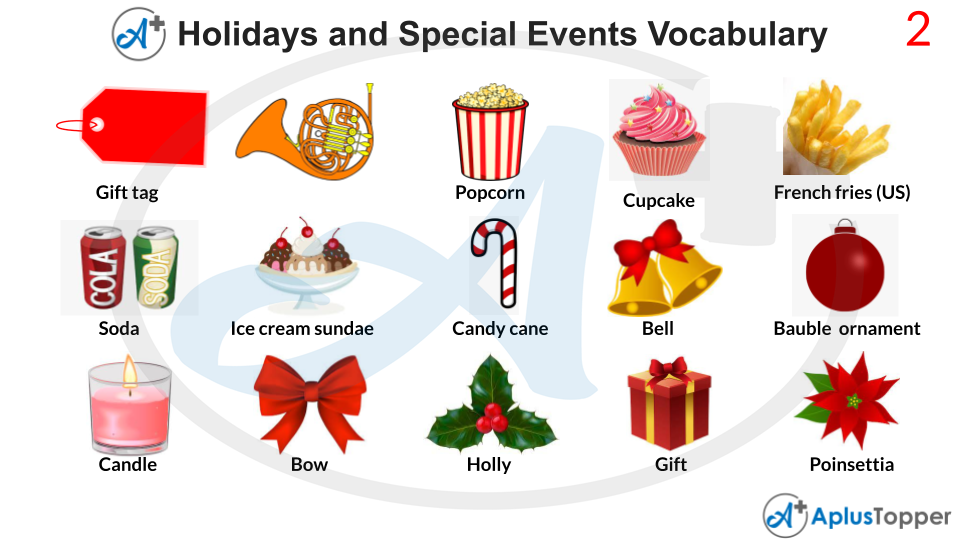
Christmas Vocabulary
A candy cane is basically a stick candy in the shape of a cane that is commonly linked with Christmas and Saint Nicholas Day. It’s often white with red stripes and peppermint flavour, but it’s also available in a number of different flavours and colours.
A jingle bell, also known as a sleigh bell, is a sort of bell that makes a unique ‘jingle’ sound when rung in large groups. They’re used as a percussion instrument in a variety of settings, including the traditional sleigh bell sound and morris dance. They are commonly used as a less expensive alternative to tiny ‘traditional’ bells.
Christmas ornaments, baubles, “Christmas bulbs,” or “Christmas bubbles” are ornaments, baubles, or “Christmas bubbles” that are used to decorate Christmas trees. These embellishments can be woven, blown (glass or plastic), moulded (ceramic or metal), carved from wood or expanded polystyrene, or created in various ways.
A candle is a combustible solid material, such as a tallow, with an ignitable wick that produces light and, in some circumstances, scent. A candle can also be used to generate heat or as a timekeeper. Traditionally, a chandler is someone who manufactures candles.
A Christmas gift, often known as a Christmas present, is a gift given during the Christmas season. Christmas gifts are frequently exchanged on Christmas Day, December 25, or on Twelfth Night, the concluding day of the twelve-day Christmas season (January 5).
According to Christian tradition, delivering presents during the Christmas season is a representation of the Three Wise Men who presents gifts to the newborn Jesus.
The poinsettia, a member of the spurge family, is an economically significant plant. The poinsettia, which belongs to Central America and Mexico, was first described by Europeans in 1834. It is well-known for its red and green leaves, and it is frequently used in Christmas flower arrangements.
The wreath became a symbol of Jesus, and four candles were used to adorn it. Red, green, white, and purple were frequently used in wreaths to signify Jesus’ blood, life, joy, sacrifice, and forgiveness. Evergreens. Christmas wreaths have traditionally been made from evergreens.
Christmas garland is one of those decorations that completes a look by covering a large area with lovely foliage and serving as a platform for lights or other ornaments. This sort of décor complements trees naturally and is available in a variety of artificial shapes, such as firs, pines, and spruces.
Christmas lights (also known as festive lights, string lights or fairy lights) are lights that are commonly used for decorating throughout the Christmas season, especially between Advent and Christmastide. The tradition dates back to when candles were used to ornament Christmas trees to represent Christ as the light of the world.
Candy, commonly known as sweets or lollipops, is a delicious confection made primarily of sugar. Any sweet confection, such as chocolate, chewing gum, and sugar candy, fall under the genre of sugar confectionery.
When Saint Nicholas (or the associated characters of Santa Claus and Father Christmas) appears, an empty sock or sock-shaped bag is hanging on Saint Nicholas Day or Christmas Eve so that he can fill it with small toys, fruit, money, sweets, or other little presents. Stocking stuffers or stocking fillers are the terms used to describe these little things.
A gingerbread man is a gingerbread biscuit or cookie in the style of a stylised human figure. However, various shapes, particularly seasonal themes (Christmas, Halloween, Easter, etc.) and characters, are popular.
A snow globe is a clear sphere, typically made of glass, that contains a miniature scene, sometimes with a model of a town, landscape, or figure. The sphere also encloses the water in the globe, which acts as a medium for the “snow” to fall through.
A Christmas tree is a decorated tree, generally an evergreen conifer like fir, spruce, or pine, or an artificial tree with a similar look, connected with the celebration of Christmas, which originated in Germany with Saint Boniface.
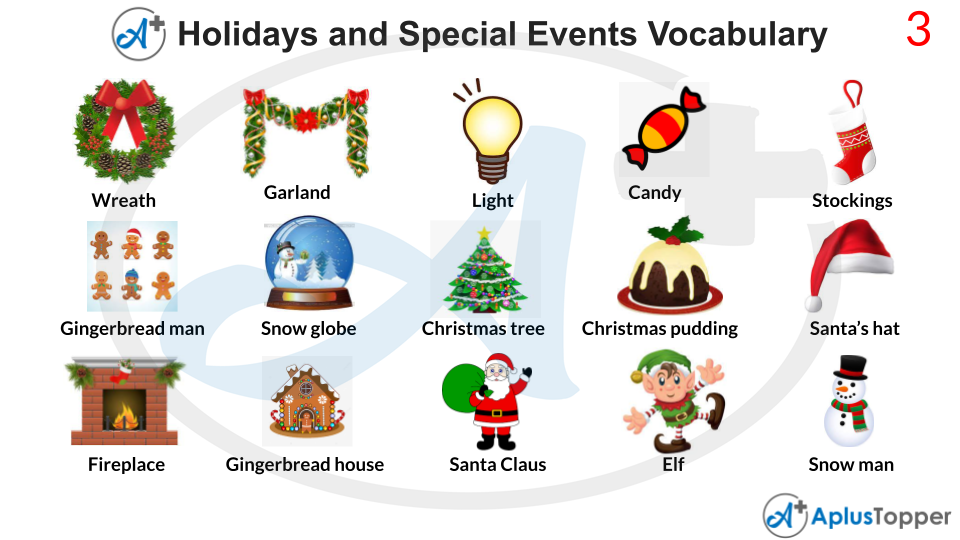
Christmas pudding is a sort of pudding that is usually eaten as part of a Christmas supper in the United Kingdom, Ireland, and other places where British and Irish immigrants have introduced it. Its origins may be traced back to mediaeval England, and it is frequently referred to as plum pudding or simply “pud,” but this term can also apply to other types of boiling pudding containing dried fruit.
A red and white hat with a white bobble on top that is linked with Santa Claus. The happy man dressed in red, complete with a red conical hat, is today’s famous figure. Santa’s headgear is in the shape of a stocking cap. A stocking hat is typically long, conical in form, and has a lovely tassel at the end.
A fireplace, often known as a hearth, is a fire-containment structure built of brick, stone, or metal. Fireplaces are primarily used to create a soothing atmosphere as well as to heat a space. The heat efficiency of modern fireplaces varies depending on the design.
A gingerbread house is a novelty dessert in the shape of a structure, composed of cookie dough and cut and baked into appropriate components such as walls and roofs. The most common ingredient is the ginger nut, a crisp ginger cookie made of gingerbread.
Santa Claus, also known as Father Christmas, Saint Nicholas, Saint Nick, Kris Kringle, or just Santa, is a mythological creature who is supposed to bring presents and candies to well-behaved children on Christmas Eve and either coal or nothing at all to bad youngsters.
In Germanic mythology and folklore, an elf is a sort of humanoid supernatural entity. Elves were typically conceived of as beings with magical abilities and extraordinary beauty in mediaeval Germanic-speaking nations, indifferent towards regular people and capable of either aiding or harming them.
A snowman is a humanoid snow sculpture that is commonly constructed in areas where snowfall is plentiful. In many regions, a traditional snowman is made up of three big snowballs of varying sizes, as well as various extra faces and other characteristics.
The word sleigh refers to a method of transportation that is specifically intended to move across ice or snow. A sleigh features an open top and seating for many passengers. It is usually big and originally constructed of wood. A sleigh required an animal to draw it, such as a horse and was the major means of transportation in the winter until the early twentieth century.
Reindeer, sometimes known as caribou in North America, is a circumpolar deer species endemic to northern Europe, Siberia, and North America’s Arctic, subarctic, tundra, boreal, and mountainous areas. Both stationary and migratory groups are affected.
My family has been making Santa Sacks for decades. They’re bigger than a pillowcase and made of reusable cloth drawstring gift bags. Our children leave an empty Santa Sack at the end of their sleeping bag on Christmas Eve (we sleep as a family next to our tree in the family room).
A Christmas card is basically a greeting card given out as part of the traditional Christmas celebration to communicate a variety of feelings about Christmastide and the holiday season between individuals.
A chimney is masonry, clay, or metal architectural ventilation structure that separates hot hazardous exhaust gases or smoke from human living spaces produced by a boiler, stove, furnace, incinerator, or fireplace. Chimneys are generally vertical, or as close to vertical as possible, to ensure that gases flow smoothly, allowing the stack or chimney effect to suck air into the combustion.
The Hanukkah menorah, also known as the hanukkiah, is a nine-branched candelabrum that is lighted throughout the eight-day Hanukkah festival. Eight of the nine branches include lights that represent the eight nights of the festival; each night, one more light is lighter than the night before, until all eight branches are lit on the final night.
A snowflake is normally a single ice crystal that has grown large enough to merge with others and subsequently descends as snow through the Earth’s atmosphere.
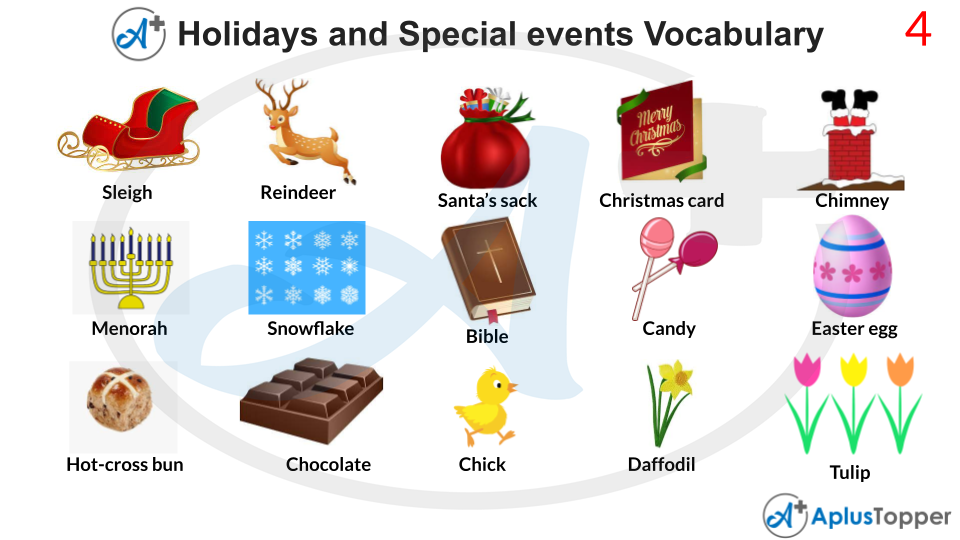
Easter Vocabulary
The Bible is originally a collection of religious texts, writings, or scriptures revered by Jews, Samaritans, Christians, Muslims, Rastafarians, and other faiths. It takes the structure of an anthology, which is basically a collection of works in various formats that are all united by the assumption that they are all divine revelations.
Candy, commonly known as sweets or lollipops, is a delicious confection made primarily of sugar. Any sweet confection, such as chocolate, chewing gum, and sugar candy, fall under the genre of sugar confectionery.
Easter eggs, also known as Paschal eggs or Easter eggs, are decorated eggs that are occasionally given as gifts. They are commonly given as Easter presents. As a result, Easter eggs are prevalent during the Easter season.
The Easter Bunny (also popularly known as the Easter Rabbit or Easter Hare) is a legendary figure and emblem of Easter who is portrayed as a rabbit carrying Easter eggs, sometimes clad in clothing. The “Easter Hare,” which originated among German Lutherans, used to perform the function of a judge, deciding whether kids or children were good or bad at the start of the Eastertide season, akin to Santa Claus’ “naughty or kind” list.
An Easter basket is a unique basket that is used during the Easter season. Depending on one’s culture, Easter baskets are usually filled with Easter eggs, food, toys, or other presents. Individuals get sweets in their Easter baskets after abstaining from them for the prior forty days of Lent, as many people do as a Lenten penance.
Ground spices, grated orange zest, and currants are included in these mildly sweet buns. They have a warm, spicy flavour with a hint of citrus. Sugar crosses piping on top provide a delicious touch.
Chocolate is a liquid, solid, or paste produced from roasted and powdered cacao pods that may be used as an ingredient for flavouring in other dishes or consumed on its own. Chocolate is one of the most popular food kinds and flavours in the world, and many sweets, including cakes, pudding, mousse, chocolate brownies, and chocolate chip cookies, include chocolate.
Crucifixion is a kind of capital punishment in which the prisoner is tied or nailed to a huge wooden beam and allowed to hang until weariness and asphyxiation kill them. The Romans, among others, employed it as a kind of punishment.
Resurrection, also known as anastasis, is the notion of resurrecting after death. A dying-and-rising god is a deity who dies and then rises again in a variety of faiths. Reincarnation is a similar process proposed by other faiths, in which the same person or god returns to live in a different body than the one they left.
For Christians, the cross is extremely important. It is similar to a Cross in the Christian community, which is a symbol of life triumphing over death. This cross serves as a reminder of Jesus Christ’s suffering and sacrifice. Because of the sins committed by humans, the Lord Jesus had to shed blood.
The flesh of domestic sheep, Ovis aries, is referred to as lamb, hogget, and mutton. A lamb is basically a sheep in its first year, and lamb meat is lamb flesh. Hogget is the meat from sheep in their second year. Mutton is the flesh of older sheep.
During the circumstances leading up to Jesus’ crucifixion, a braided crown of thorns was put on his head, according to the New Testament. It was one of the Passion’s weapons, used by Jesus’ captors to both inflict agony and ridicule his claim to power.
A pattern is a recurring pattern in the natural world, human-made design, or abstract concepts. As a result, a pattern’s elements repeat in a predictable manner. A geometric pattern is a repeating pattern made up of geometric forms, similar to a wallpaper design. Patterns can be observed immediately with any of the senses.
Daffodil, narcissus, and jonquil are some of the common names used to designate all or some species of the genus. Narcissus is a genus of mostly spring-flowering perennial plants in the Amaryllidaceae family, which includes amaryllis.
Tulips fall under the genus of perennial herbaceous bulbiferous geophytes that bloom in the spring. The blooms are often big, showy, and vividly coloured, with red, pink, yellow, or white being the most common colours. Internally, they typically have a distinct coloured splotch at the base of the tepals.

Halloween Vocabulary
The “vampire” bats are one of three species that feed exclusively on blood, whereas the other 1,300 species eat insects, rodents, and nectar. The gang as a whole acquired its Halloween connection from these vampire bats. Bats have a bad stigma, but they’re actually rather adorable!
The black cat is connected with witchcraft and evil in many ancient Pagan faiths. Because of our forefathers’ concerns, black and night have long been associated with evil. This tradition was maintained throughout the Middle Ages, when witches were supposed to be able to transform into a black cat at will.
The personification of evil as it is conceptualised in many cultures and theological traditions is referred to as a devil. It’s said to be the objectification of hostile and destructive energy. It’s interesting to think about the devil through the eyes of the many civilisations and faiths that include the devil as a component of their mythos.
A mummy is a deceased animal or particularly a human whose soft tissues and organs have been preserved by exposure to chemicals, severe cold, very low humidity, or absence of air, either intentionally or accidentally, so that the retrieved corpse does not deteriorate further if kept cool and dry.
In ghostlore, a haunted home, spook house, or ghost house is a house or other structure that is assumed to be haunted by the souls of the dead who may have been past occupants or were somehow linked with the site.
A cemetery, burial ground, gravesite, or graveyard is a location where people’s ashes are buried or otherwise placed. The term cemetery refers to territory that has been expressly designated as a burial place, and it was first used to describe the Roman catacombs.
A ghost is the soul or spirit of a deceased person or animal who can appear to the living in folklore. Ghost accounts range from an undetectable presence to translucent or barely visible wispy shapes to realistic, lifelike figures in ghostlore.
A jack-o’-lantern is a Halloween-themed carved pumpkin, turnip, or other root vegetable lantern. The phenomena of odd lights flashing above peat bogs, known as will-o’-the-wisps or jack-o’-lanterns, inspired the name.
A cauldron (or caldron) is a big pot (kettle) with a cover and an arc-shaped hook for boiling or cooking food over an open fire. To put it another way, a big kettle. Cauldrons are no longer widely used as cooking pots in the developed world.
The costume is an individual’s or group’s particular style of dress or cosmetics that represents class, gender, profession, ethnicity, nationality, activity, or era. In a nutshell, the outfit represents the people’s cultural perspective. Halloween costumes are costumes worn around or on October 31, the day before Halloween.
A lady with magical abilities, particularly wicked ones, is commonly portrayed as wearing a black cloak and pointed cap and riding a broomstick. Witchcraft is the practise of supernatural talents and powers, such as casting spells and performing magical rituals, that the practitioner thinks he or she possesses.
Witchcraft is a wide word with many cultural and socioeconomic variations, making it difficult to describe precisely.
A witch hat is a hat with a conical crown and a broad brim that is worn by witches in popular culture portrayals. The origins of the witch hat as it is seen today are debatable. This hat type was possibly connected with black magic, Satan worship, and other crimes of which Jews were accused.
Candy, commonly known as sweets or lollipops, is a delicious confection made primarily of sugar. Any sweet confection, such as chocolate, chewing gum, and sugar candy, falls under the genre of sugar confectionery.
Owls belong to the Strigiformes order, which contains approximately 200 species of primarily nocturnal and solitary birds of prey with an erect stance, a big, wide head, binocular eyesight, binaural hearing, keen claws, and quiet flying feathers.
Calaveras, or the depiction of a skull in clay or candy form (hence the English title “sugar skull”), are eerie. It’s a collection of skulls! But that’s where the similarity ends.
A tomb or grave is marked with a stone or monument, generally with an engraved inscription.
Witch’s broom, often known as witches’ broom, is a malformation in which the normal structure of a woody plant, usually a tree, is altered. A thick cluster of shoots develops from a single point, like a broom or a bird’s nest in appearance. Pathogens are occasionally to blame.
A spider web, also known as a spiderweb, spider’s web, or cobweb, is a web made by a spider from proteinaceous spider silk extruded from its spinnerets that are used to trap food.
A skeleton is the structural framework that holds an animal’s body together. There are two sorts of skeletal structures: the exoskeleton, which is an organism’s sturdy outer shell, and the endoskeleton, which is the body’s support structure.
Spiders are eight-legged air-breathing arthropods having chelicerae with teeth that can typically inject venom and spinnerets that extrude silk. They are the biggest spider order and have the sixth-highest overall species diversity of all creatures.
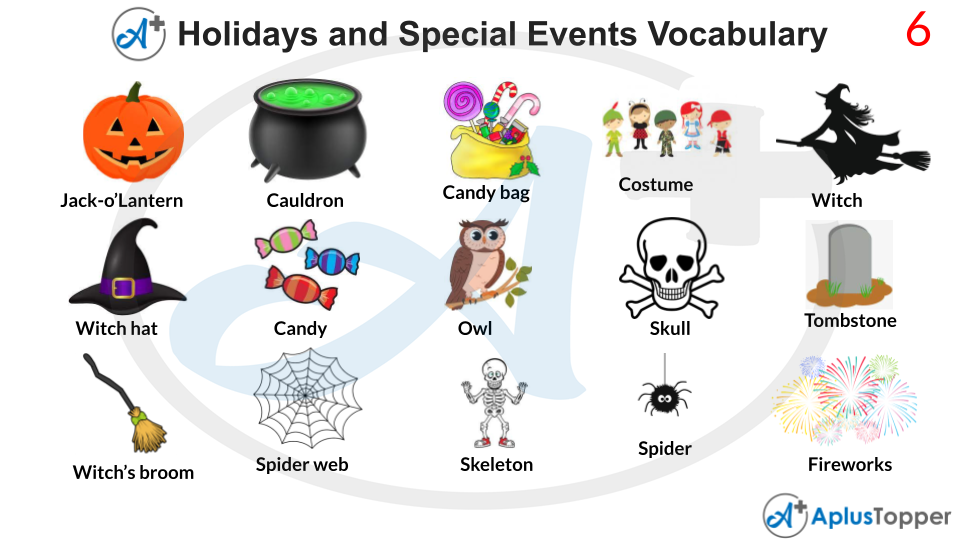
New Year’s Eve Vocabulary
Fireworks are a type of low-explosive pyrotechnic device that is used for display and amusement. A firework is most commonly used as part of a fireworks display (also known as a fireworks show or pyrotechnics), which is a demonstration of the effects created by fireworks devices.
A countdown is a series of backward counting that indicates the amount of time until an event takes place. The explosion of an explosive, the commencement of a race, the start of the New Year, or any other keenly awaited occasion are all examples of events for which countdowns are widely utilised.
A party hat is any of several types of celebratory hats, the most common of which is a conical hat made of thin paperboard with designs printed on the outside and a long string of elastic acting as a chinstrap, running from one side of the cone’s bottom to the other to secure the cone to the person’s head. Party hats are most commonly worn at birthday parties, particularly by the honoured guest, or at New Year’s Eve celebrations.
A firecracker (also known as a noisemaker or banger) is a tiny explosive device used to generate a lot of noise, generally in the form of a loud explosion, mainly for celebration or amusement; any visual impact is secondary. To confine the explosive composition, they include fuses and are encased in a thick paper casing. Firecrackers, like fireworks, have their origins in China.
Champagne is a sparkling wine created in France’s Champagne wine region under appellation rules that require specific vineyard practices, grape sourcing exclusively from designated areas within the appellation, specific grape pressing methods, and to produce secondary carbonation, fermentation of the wine in the bottle is necessary.
Confetti is a term for little bits of paper, mylar, or metallic material that are thrown during events such as parades and weddings. Confetti is created in a diversity of colours, and commercially produced confetti comes in a variety of forms.
A mask is a piece of clothing that is generally worn on the face for the purpose of protection, disguise, performance, or amusement. Masks have been used for ceremonial and practical purposes, as well as in the performing arts and entertainment, since antiquity.
An hourglass (also named a sand timer, sandglass, sand clock, or egg timer) is a time-keeping device. It is build of two glass bulbs linked vertically by a short neck that permits a controlled flow of a substance (in this case, sand) from the upper bulb to the bottom one. The top and lower bulbs are usually symmetrical such that the hourglass measures the same length regardless of orientation.
A balloon is a flexible bag that may be filled with helium, hydrogen, nitrous oxide, oxygen, or air and then inflated. Balloons can be filled with smoke, granular media, liquid water (such as sand, flour, or rice) or light sources for specific activities. Modern balloons are constructed of a variety of materials, including rubber, latex, polychloroprene, and nylon fabric, and come in a variety of colours.
A party favour, often known as a favour, is a little present given to attendees during a party which is represented as a token of appreciation, a remembrance of the event, or just as an aid to frivolity.
Crepe paper streamers are the most adaptable party decorations available. They can generate a lot of effect for a little price because they’re 81 feet long. Make a balloon tassel out of crepe paper streamers by attaching them to a Big Balloon. This elegant background was created with only hanging Crepe streamers and gold ribbon.
A postcard, often known as a postcard, is a rectangular piece of thick paper or thin cardboard used for writing and shipping without the need for an envelope. Non-rectangular forms are also possible, but they are uncommon.
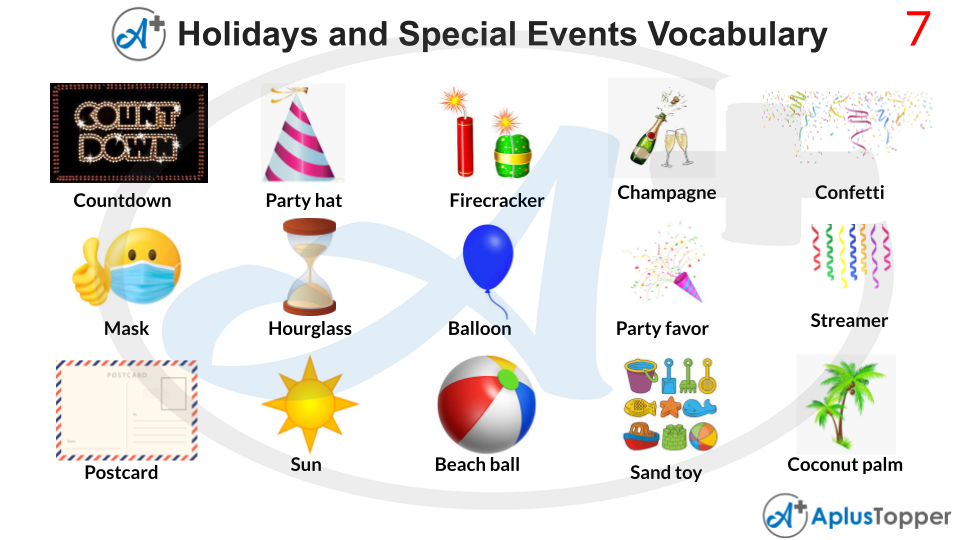
Summer Vocabulary
The Sun is the central star in the Solar System. It’s a nearly perfect sphere of hot plasma, heated to incandescence in its centre by nuclear fusion processes and emitting energy mostly as visible light, ultraviolet light, and infrared radiation.
A big, light, buoyant ball used mostly for beach sports, swimming pools, and other water-based activities. Beach balls are perfect for trained seals to balance on their noses due to their small weight and stability, which has become an iconic scene. Beach balls are also a common accessory in swimwear photography and for promoting or representing beach-themed events or destinations.
A coconut palm is a tall tree that produces coconuts. The coconut tree is the only extant species of the genus Cocos, and it belongs to the palm tree family. The name “coconut” can indicate to the entire coconut palm, the fruit, or the seed, according to botanical classification, which is a drupe, not a nut.
A beach is a small strip of land that separates inland areas from a body of water. Beaches are often comprised of sand, small pieces of rock, and minerals that have been worn down by continual wind and wave action. A beach is a small, gently sloping strip of ground that runs along the edge of a body of water, for example, a lake, a river or an ocean.
A deckchair is a foldable chair with a block of treated wood or another material frame. The word today generally refers to a portable folding chair with a backrest and seat made of a single strip of fabric or vinyl. It was initially designed for leisure on the deck of an ocean liner or cruise ship.
A replica of a castle or duplicate castle made of sand, usually made by youngsters. Sand art, also known as a sand brushing, sand sculpting, sandpainting, or sand bottles, is the process of shaping sand into an aesthetic shape. A sandcastle is a sand creation that resembles a small structure, most commonly a castle.
Beach towels are generally used to protect people from the sand on the beach or the concrete around a pool. Beach towels dry fast in the sun due to their thinness.
A bikini is a two-piece swimsuit for women that has two fabric triangles on top that cover the breasts and two fabric triangles on the bottom: the front covering the pelvis but exposing the back covering the buttocks and the navel.
Swim trunks are short, loose-fitting or tight-fitting shorts worn for sports such as boxing, swimming, and track and field. Trunks are sometimes referred to as swimming trunks or bathing trunks when worn as a swimsuit and are typically shorter than board shorts, which stretch to the knees.
A person who comes to spend time with or stay with people or at a place is referred to as a visitor, caller, guest, or visitant. A visitor to our neighbour’s house frequently stays for a while, whether for social reasons, business, sightseeing, or other reasons.
On sunny beaches, lawns, and other areas, a big umbrella is utilised to offer shade. We’ll just say it right now: you need to carry an umbrella to the beach. Consider ultraviolet (UV) rays. If you don’t bring an umbrella, you’re setting yourself up for sunburn and a headache the next day from too much sun, and your beach day deserves more.
The coconut tree is the only extant species of the genus Cocos, and it belongs to the palm tree family. The name “coconut” can be indicated to the entire coconut palm, the fruit, or the seed.
Goggles, more commonly referred to as safety glasses, are a form of protective eyewear that encloses or shields the area around the eye to keep out particles, water, and chemicals. They are used in chemical research laboratories and the woodworking industry. They are commonly used in a variety of activities, including skiing and swimming.
Flip-flops are a type of flat, backless sandal with basic soles kept on the foot by a V-shaped strap that runs between the toes and around each side of the foot, connecting to the sole at three locations in footwear and design (viz., between the toes and on either side).
A hat is basically a head covering used for a variety of reasons, including protection from the elements, ceremonial purposes such as university graduations, religious reasons, safety, and fashion.
A floater is tube with which one relaxes in a pool while floating on their back. Pennies will sink in water, while a dollar note, as well as dragonflies on a lake’s surface and beach balls bobbing in the waves, will float.
Sunglasses, often known as sunglasses, are a type of protective eyewear meant to shield the eyes from intense sunshine and high-energy visible light.
Sunscreen, often known as suncream, sunblock, or suntan lotion, is a photoprotective topical treatment for the skin that absorbs or reflects part of the sun’s UV rays, therefore assisting in the prevention of sunburn and, more significantly, skin cancer.
A swimming pool, commonly called a swimming bath, paddling pool, wading pool, or simply a pool, is a structure built for water-holding for used for swimming and other activities related to leisure. Pools can be built into the ground ( which are called in-ground pools) or above ground (above-ground pools), and they are a common feature on cruise ships and ocean liners.
A swimsuit is a piece of clothing meant to be worn by persons participating in water-based activities or water sports like swimming, diving, and surfing, as well as sun-oriented activities like sunbathing.
Surfing is done on a narrow plank called a surfboard. Surfboards are small and light, yet they are sturdy enough to sustain a person standing on them while riding a wave on the ocean. Polyurethane or polystyrene foam is coated with layers of fibreglass fabric and polyester or epoxy resin in modern surfboards. The result is a surfboard that is both light and robust, as well as buoyant and manoeuvrable.
A canoe is a small, lightweight watercraft with pointed ends and an open top that is driven by one or more sitting or kneeling paddlers facing the direction of travel, each using a single-bladed paddle.
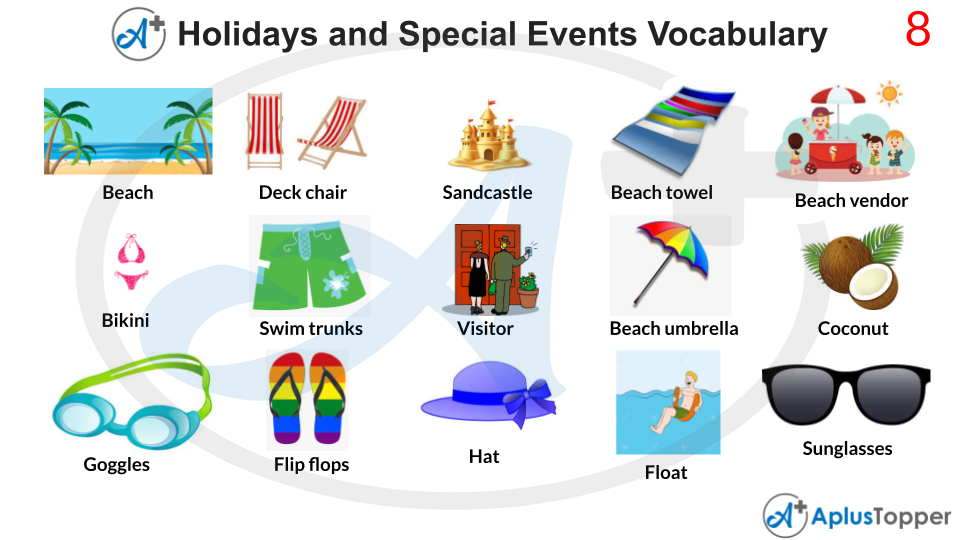
Wedding and Marriage Vocabulary
A church building, sometimes known as a church house or a small church, is a structure used for Christian worship and other religious activities. The phrase is commonly used to describe both the physical structures where Christians worship and the Christian community.
Wedding bells are an important part of many weddings, particularly religious ones. Church bells were once rung at the conclusion of a ceremony to proclaim a couple’s marriage. The sound of the chimes was also said to ward off evil spirits, giving a good fortune to the newlyweds.
Champagne is ordinarily a sparkling wine produced in France’s Champagne wine region under appellation rules that require specific vineyard practices, grape sourcing exclusively from designated areas within the appellation, specific grape pressing methods, and secondary fermentation in the bottle of the wine is necessary to cause carbonation.
Banquet Hall refers to a structure or a section of a building that is hired or booked for private gatherings such as banquets, weddings, anniversaries, and other such festivities by individuals, corporations, or groups.
A honeymoon is basically a vacation taken by newlyweds to commemorate their marriage shortly after their wedding. Nowadays, honeymoons are frequently held in exotic or romantic locations.
A wedding cake is a classic cake served after dinner at wedding festivities. The wedding cake is served at a wedding breakfast in some regions of England; ‘wedding breakfast’ does not indicate the meal will be served in the morning, but rather after the ceremony on the same day.
An engagement ring, especially in Western cultures, is a ring that indicates that the person wearing it is engaged to be married. When a partner proposes marriage or when a marriage proposal is approved, they give their potential spouse an engagement ring.
Confetti is a term for little bits of paper, mylar, or metallic material that are thrown during events such as parades and weddings. The word confetti is derived from the Latin word confectum, which means “little sweet.”
An invitation is a request, a solicitation, or an attempt to persuade someone else to attend an event with you. When you invite someone to a party, visit your beach home, or witness your wedding, you’ve invited them — and you’ve given them an invitation.
A veil is a piece of clothing or a hanging material that is used to conceal a part of the head or face or a significant item. In European, Asian, and African civilizations, veiling has a long history. In Judaism, Christianity, and Islam, the practice has taken on many forms.
The bride’s wedding gown, also known as a bridal gown, is the gown she wears during the wedding ceremony. The color, design, and ceremonial significance of the gown might be influenced by the wedding guests’ faith and culture.
A bride is a lady who is getting married or has just married. When a lady marries, her future husband is referred to as the bridegroom or simply the groom. A maid, a groomsman, and one or more bridesmaids may accompany a bride in Western society.
A bridegroom is described as a man who is getting married or has just married. The bridegroom’s future spouse is typically referred to as the bride when they marry. A best man and groomsmen are usually present during the wedding of a bridegroom.
In a Western traditional wedding ceremony, bridesmaids are members of the bride’s party. A bridesmaid is usually a young lady who is a close friend or family of the bride. On the day of a marriage or wedding ceremony, she looks after the bride. Bridesmaids were traditionally chosen from unmarried young ladies of marriageable age.
In a wedding ceremony, a groomsman or usher is one of the male attendants to the groom. It is customary for the groom to choose close friends and family to serve as groomsmen, and it is quite a privilege to be chosen. The groom generally selects one of his groomsmen to serve as the best man.
A priest is considered a religious leader who is permitted to carry out a religion’s holy rites, especially as a mediator connecting humans and one or more deities. They also have the ability or authority to perform religious ceremonies, such as sacrifices to and propitiation of a god or gods.
A composer, conductor, or performer of music is referred to as a musician. The United States Employment Service defines “musician” as “a broad word used to identify someone who pursues music as a career.”
During a bridal procession, a flower girl is a young female who spreads flower petals down the aisle. Flower girls are generally three to 10 years old and are members of the bride or groom’s extended friend or family of either family in a traditional bridal procession.

Valentine’s Day
Someone who has been involved in a sexual or romantic connection with another individual. a person with whom one has a sexual relationship outside of marriage. A person who is extremely enthusiastic about or fond of something, as defined: a music aficionado.
Cupid, the ancient Roman deity of love in all its forms, is the Greek god Eros’s counterpart and Latin poetry’s equivalent of Amor. He was frequently shown as a winged baby with a bow and quiver of arrows, whose wounds generated love or desire in the hearts of his victims.
One of Cupid’s arrows, which is said to induce the person who is struck by it to fall in love. Daphne was struck by Cupid’s arrow at a time when she thought she’d moved on from such things. Cupid’s arrow is believed to strike anyone at any time.
Chocolate is a liquid, solid, or paste produced from roasted and powdered cacao pods that may be used as an ingredient for flavouring in other dishes and consumed on its own. The cacao tree’s seeds have a strong bitter flavour that must be fermented to bring out the flavour. The beans are dried, cleaned, and roasted after fermentation.
A soft toy in the shape of a bear is known as a teddy bear. Teddy bears are one of the most popular children’s presents, and they are frequently given to adults to express affection, congrats, or compassion. Teddy bears have come a long way in terms of form, design, colour, and substance since the first ones were created to resemble the shape of actual bear cubs.
A gift, often known as a present, is anything given to someone without expecting anything in return. If the person receiving the present already owns the item, it is not considered a gift. Although there may be an expectation of reciprocity when making a gift, it is intended to remain unrequited.
In many nations, the act of trading money, products, and other items with one another can help to maintain social bonds and contribute to social cohesiveness.
Perfume is a liquid combination of fragrant essential oils or aroma compounds, fixatives, and solvents used to impart a pleasant fragrance to the human body, animals, food, objects, and living environments.
Candy, often known as sweets in British English or lollies in Australian and New Zealand English, is a sweet confection made primarily of sugar. Any sweet confection, such as chocolate, chewing gum, and sugar candy, fall under the genre of sugar confectionery.
A balloon is a flexible bag that may be filled with helium, hydrogen, nitrous oxide, oxygen, or air and then inflated. Balloons can be filled with smoke, granular media (such as sand, flour, or rice), liquid water, or light sources for specific activities. Modern balloons are constructed of a variety of materials, including rubber, latex, polychloroprene, and nylon fabric, and come in a variety of colours.
A gift card also accounted as a gift certificate in North America or a gift voucher or gift token prevalent in the United Kingdom is a prepaid stored-value money card provided by a shop or bank to be used instead of cash for purchases inside a certain store or associated businesses.
A ring is basically a circular piece of jewellery, generally made of metal, that is worn as decorative jewellery. When someone is worn as an ornament elsewhere, the body part is mentioned within the phrase, e.g., earrings, neck rings, toe rings and arm rings; when worn as an ornament elsewhere, the body part is stated within the term, e.g., earrings, neck rings, arm rings, and toe rings.
